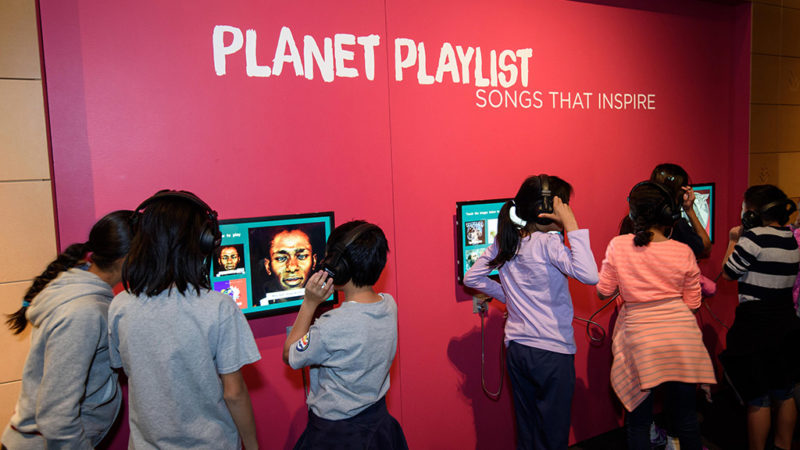
Blog |
Out of the Blue and Into Your Eardrums
by Karen A. Lefkowitz
What do people need to hear to care about Earth’s biodiversity? What vibrations need to be felt to motivate action?
UCLA conservation biologist and IoES faculty member Paul Barber is about to find out.
A new interactive multimedia exhibit from the California Science Center, Grammy Museum and Global Wildlife Conservation — Earth in Concert: Protecting the Planet through Music — includes a display pairing Barber’s marine research in the Coral Triangle of the western Pacific Ocean with melodies and advocacy from artists Jack Johnson and Pharrell Williams, each of whom are concerned with the impact of plastic pollution on ocean life.
“Promoting sustainability of marine biodiversity is critical for our society. The sea is a major source of jobs, economic growth, and future pharmaceutical discovery,” says Barber.
He continues, “The decline of marine ecosystems is compromising food security, and could lead to political instability in key regions of the globe. These ecosystems are ‘too big to fail’.”
Protecting our Planet’s Colorful Coral Reefs
Barber has done research in Indonesia for close to two decades. In the last four years he’s focused on autonomous reef monitoring structures – devices put into the ocean for a few years that become colonized by marine organisms. The structures are used to access biodiversity: see how it changes over space and time and is impacted by environmental stressors, like pollution. Coral reefs are ecologically and economically important, and very threatened.
Called the “Amazon of the Ocean” due to its incredible variety of species, Barber returns to the spots in the Coral Triangle where the devices are installed every couple of years, collects the structures, and brings the biological materials (animal life that has accumulated on the devices) on to dry land to his lab at UCLA. He then uses cutting-edge molecular genetic techniques to determine exactly what is living in the reefs. Barber explains, “By using DNA coding you can precisely identity individual species, really allowing you to survey diversity across lots of different organisms.”
“Paul’s work is significant, with respect to inclusion in Earth in Concert, in three important ways,” says California Science Center Curator of Ecology Chuck Kopczak.
“First, he’s seeking to understand how all of this amazing diversity evolved in this particular part of the ocean. Second, his work can help us understand how human activities impact diversity of coral reefs. Third, his commitment to improving the human diversity of scientists studying coral reefs, and the ocean in general, is noteworthy.”
Barber’s first interaction with the California Science Center came about working with Kopczak to bring diversity program students to scuba dive in the museum’s live kelp forest. The Diversity Project is an international integrative undergraduate research program for underrepresented minority students interested in marine and evolutionary biology. The research intensive educational program combines fieldwork on the coral reefs of the Indo-Pacific with cutting edge molecular genetic research.
Linking Artistic Expression and Scientific Investigation
Fusing the expressiveness of music with eye-opening discoveries, the intention of the exhibit is to inform, inspire, and demonstrate what musicians and scientists like Barber are doing to preserve the natural world. The soft rock and acoustic tunes of Johnson and hip hop, funk, soul, and R&B rhythms of Williams are presented alongside the sights and sounds of coral reefs and the aquatic life that reside in this part of the sea. Original writings, unique footage, and personal artifacts from the artists are featured with detailed looks at the research being conducted in this environment.
Diving into the marine habitat Barber studies, visitors can discover the diversity of species that settle on tropical coral reefs through high resolution magnified images and complete a new composition by Jack Johnson about reducing plastic pollution in the ocean. Interactive components invite visitors to listen to animal calls and use sight and touch to investigate animal behavior.
“What I hope people can come away from the exhibit with is the knowledge that we are facing all kinds of environmental problems and ultimately all of them unfortunately are impacting the planet’s biodiversity. Biodiversity is the glue that keeps ecosystems together and so the exhibition presents strongly the notion that these ecosystems are providing important benefits to all living things,” says Kopczak.
“That is really the message we’d like people to take away: that we’re all part of this system. It’s not like we’re outside of nature — the things we do are part of that and have an impact, in some cases negatively and in some cases positively, but we have to take that into account as we sort out how we’re going to live on this planet sustainably in the future.”
Produced using environmentally sustainable materials and currently open at the California Science Center through spring 2016, Earth in Concert will eventually travel to other science museums, zoos, and aquariums to further share how artists and scientists are using their talents to protect our planet.
